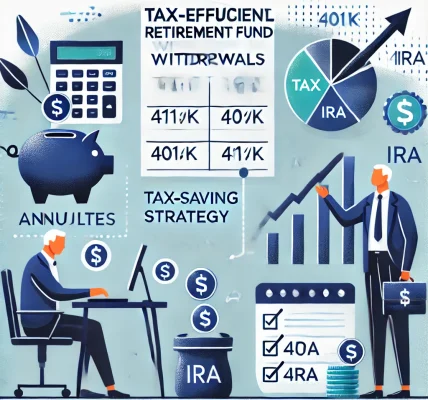Introduction
Being self-employed provides freedom and flexibility, but it also comes with the responsibility of planning for your own retirement. Unlike traditional employees who have access to employer-sponsored 401(k) plans and pension schemes, self-employed professionals must take proactive steps to secure their financial future. This guide will help you understand the best retirement savings options, tax advantages, and strategies for long-term financial security.
Why Retirement Planning is Crucial for Self-Employed Professionals
Many self-employed individuals focus on growing their businesses but often overlook retirement planning. Without a structured plan, you may find yourself without sufficient savings in your later years. The key benefits of retirement planning include:
- Financial Security: Ensuring a steady income stream after retirement.
- Tax Benefits: Many retirement plans offer tax-deferred or tax-free growth.
- Compounding Growth: The earlier you start, the more your investments grow over time.
- Peace of Mind: A well-planned retirement ensures stability for you and your family.
Best Retirement Plan Options for Self-Employed Professionals
1. Solo 401(k)
A Solo 401(k) is a powerful retirement savings tool designed for self-employed individuals and small business owners with no employees (except a spouse).
Benefits:
- High contribution limits: Up to $66,000 (or $73,500 if age 50+) in 2024.
- Contributions are tax-deductible, reducing taxable income.
- Can include a Roth option for tax-free withdrawals in retirement.
- Allows for employer and employee contributions, maximizing savings.
Contribution Limits:
- Employee contribution: Up to $23,000 (or $30,500 if age 50+).
- Employer contribution: Up to 25% of net earnings.
2. SEP IRA (Simplified Employee Pension IRA)
A SEP IRA is an excellent option for self-employed professionals and business owners looking for a simple and flexible retirement plan.
Benefits:
- High contribution limits: Up to 25% of net earnings, capped at $66,000 in 2024.
- Easy to set up and administer with minimal paperwork.
- Tax-deferred growth until withdrawals in retirement.
- No required contributions, providing flexibility based on income.
3. SIMPLE IRA (Savings Incentive Match Plan for Employees)
A SIMPLE IRA is a retirement plan option for small business owners with employees. However, it can also work for self-employed individuals.
Benefits:
- Lower contribution limits than a Solo 401(k) or SEP IRA but easier to manage.
- Employer contributions required but tax-deductible.
- Contributions grow tax-deferred.
- Contribution limit: $16,000 in 2024 ($19,500 for those 50 and older).
4. Traditional and Roth IRAs
An Individual Retirement Account (IRA) is an accessible retirement savings option with tax advantages.
Traditional IRA Benefits:
- Contributions are tax-deductible.
- Withdrawals in retirement are taxed as regular income.
- Annual contribution limit: $7,000 ($8,000 for those 50+).
Roth IRA Benefits:
- Contributions are made with after-tax income.
- Withdrawals in retirement are tax-free.
- Ideal for those expecting to be in a higher tax bracket later in life.
- Same contribution limits as a Traditional IRA.
5. Taxable Investment Accounts
If you’ve maxed out your retirement accounts, a taxable brokerage account can be another investment option.
Benefits:
- No contribution limits.
- More flexibility in investment choices.
- No early withdrawal penalties, unlike retirement accounts.
Tax Advantages of Retirement Plans for Self-Employed Individuals
One of the biggest benefits of retirement planning is the tax advantages these plans offer:
- Tax-Deferred Growth: Retirement accounts like a Solo 401(k) and SEP IRA allow investments to grow tax-free until withdrawals are made in retirement.
- Tax Deductions: Contributions to traditional retirement plans reduce taxable income, lowering your annual tax bill.
- Roth Options for Tax-Free Withdrawals: Roth IRAs and Roth 401(k)s provide tax-free withdrawals in retirement.
How Much Should You Save for Retirement?
The amount you need to save depends on factors such as your desired retirement lifestyle, expected expenses, and inflation. Here are some general guidelines:
- Aim to save 15-20% of your income for retirement.
- Follow the 4% rule: This rule suggests withdrawing 4% of your retirement savings annually to ensure your funds last.
- Calculate your retirement number: Multiply your annual expenses by 25 to estimate the total savings you need.
Common Mistakes to Avoid in Retirement Planning
- Delaying Savings: The earlier you start, the more you benefit from compound growth.
- Not Diversifying Investments: Relying on one type of investment can increase risk.
- Ignoring Tax Implications: Choose the right plan based on your current and future tax situation.
- Withdrawing Funds Early: Early withdrawals can trigger penalties and reduce your retirement savings.
- Not Planning for Healthcare Costs: Consider setting aside funds for medical expenses in retirement.
Final Thoughts
Retirement planning for self-employed professionals requires proactive effort and strategic decision-making. By choosing the right retirement plan, maximizing contributions, and leveraging tax benefits, you can secure a financially stable future.
Key Takeaways:
✅ Start saving early to take advantage of compounding growth. ✅ Choose the right retirement plan based on income and tax benefits. ✅ Maximize contributions to reduce taxable income. ✅ Diversify investments for long-term stability. ✅ Plan for healthcare and unexpected expenses.




